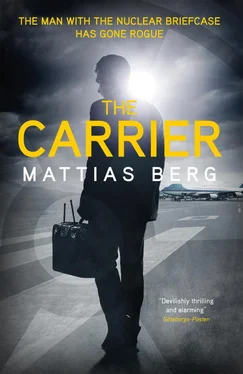Mattias Berg - The Carrier
Здесь есть возможность читать онлайн «Mattias Berg - The Carrier» весь текст электронной книги совершенно бесплатно (целиком полную версию без сокращений). В некоторых случаях можно слушать аудио, скачать через торрент в формате fb2 и присутствует краткое содержание. Город: London, Год выпуска: 2019, ISBN: 2019, Издательство: MacLehose Press, Жанр: Триллер, на английском языке. Описание произведения, (предисловие) а так же отзывы посетителей доступны на портале библиотеки ЛибКат.
- Название:The Carrier
- Автор:
- Издательство:MacLehose Press
- Жанр:
- Год:2019
- Город:London
- ISBN:978-0-85705-788-4
- Рейтинг книги:4 / 5. Голосов: 1
-
Избранное:Добавить в избранное
- Отзывы:
-
Ваша оценка:
- 80
- 1
- 2
- 3
- 4
- 5
The Carrier: краткое содержание, описание и аннотация
Предлагаем к чтению аннотацию, описание, краткое содержание или предисловие (зависит от того, что написал сам автор книги «The Carrier»). Если вы не нашли необходимую информацию о книге — напишите в комментариях, мы постараемся отыскать её.
The Carrier — читать онлайн бесплатно полную книгу (весь текст) целиком
Ниже представлен текст книги, разбитый по страницам. Система сохранения места последней прочитанной страницы, позволяет с удобством читать онлайн бесплатно книгу «The Carrier», без необходимости каждый раз заново искать на чём Вы остановились. Поставьте закладку, и сможете в любой момент перейти на страницу, на которой закончили чтение.
Интервал:
Закладка:
Mattias Berg
THE CARRIER
Translated from the Swedish by George Goulding
FOR
LINDA, VERA
and GRETA
“The end of war is peace or victory. But to the question, what is the end of peace, there is no answer.”
HANNAH ARENDT, On Violence-
April 2013:
In an unprecedented move, a U.S. Air Force commander stripped 17 of his officers of their authority to control and launch nuclear missiles.
The officers, based in Minot, North Dakota, did poorly in an inspection. They were ordered to undergo 60 to 90 days of intensive refresher training.
August 2013:
A missile unit at Malmstrom Air Force Base failed a safety and security inspection “after making tactical-level errors—not related to command and control of nuclear weapons,” the Air Force Global Strike Command said.
The 341st Missile Wing operates about 150 of the 450 Minuteman III nuclear-tipped intercontinental ballistic missiles in the U.S. forces, according to an Air Force statement.
October 2013:
A military officer with high-level responsibility for the country’s nuclear arsenal lost his job.
He was formally relieved of his duties as deputy chief of U.S. Strategic Command. A military official said his demotion was connected to allegations that he used counterfeit gambling chips at a casino.
October 2013:
Just days later, a U.S. general who oversaw nuclear weapons was relieved of his duties after he boozed, fraternized with “hot women” and disrespected his hosts during an official visit to Russia, Air Force officials said.
The General led the 20th Air Force, responsible for three nuclear wings.
According to an Air Force Inspector General report, he bragged loudly about his position as commander of a nuclear force during a layover in Switzerland, saying he “saves the world from war every day.”
January 2014:
At the Montana base, 34 Air Force officers entrusted with maintaining nuclear missiles are accused of cheating or turning a blind eye to cheating on a competency test.
From C.N.N.’s “Nuclear Scandals Timeline”, January 2014KANSAS CITY, M.O.—A sprawling new plant here in a former soybean field makes the mechanical guts of America’s atomic warheads. Bigger than the Pentagon, full of futuristic gear and thousands of workers, the plant, inaugurated last month, modernizes the ageing weapons that the United States can fire from missiles, bombers and submarines.
It is part of a nationwide wave of atomic revitalization that includes plans for a new generation of weapon carriers. A recent federal study put the collective price tag, over the next three decades, at up to a trillion dollars.
This expansion comes under a president who campaigned for ‘a nuclear-free world’ and made disarmament a main goal of American defense policy.
From the New York Times , September 20141
Snap
September 2013
Stockholm
1.01
I had been so very close to the President. Never more than a few feet away during official duties, always with my briefcase prepared. Even when he accepted the Nobel Peace Prize. When he gave that damned speech about a world without nuclear weapons.
You must understand. But you won’t.
How we had been consumed, taken in, seduced yet again by the fire. Not so much through our guilt as our innocence. My own diabolical innocence.
We called it “The Nuclear Football”, as if it was some kind of game. And talked about “Pressing the Button”, but there was neither a button nor anyone who did any actual pressing. To me it was more like an occult ceremony, a magical-technological transformation trick. Carrying out a series of procedures in the correct sequence, with the help of the codes, to render insecure the one thing in our entire civilization that should be the most secure of all.
The contents of the briefcase had been so highly classified that few apart from us knew about them. From the start there were only four primitive objects there. The Black Book with every possible operational option for retaliation or attack; a folder listing the underground bases to which the President could be taken at times of maximum alert; a note summarizing the structure of our nuclear weapons system. And then the square plastic counter with the codes the President was to use when identifying himself to Centcom. We called it “the biscuit”.
During the Cold War, it was more or less understandable. As soon as the briefcase was opened a signal was transmitted to Centcom. After the President had used “the biscuit” to confirm his identity, he and the Carrier of the briefcase faced a number of choices according to the war plan then in place. The last step was for Centcom to follow the President’s order and carry out the launch itself.
But things had become complicated with the developing wizardry of digital technology, as well as our own much-altered war plan. We were assured that the guiding principle was still “Always-Never”. The nuclear weapons should always be ready for launch within half an hour, but never capable of being dispatched in error.
Yet over the last decade the boundaries had been extended with each new technological advance. Once both circuits and microprocessors had become small enough, it was possible to integrate parts of the detonation mechanism into the briefcase itself. Centcom now seemed more or less superfluous. Everything merged into a single whole. The difference between “always” and “never” began to dissolve. In the end it became impossible, even for me, to distinguish between safety measures and launch procedures.
That is when the thought of escape came to me.
1.02
Our gigantic sortie took off into a clear blue morning sky, like a lumbering bumblebee defying gravity. As usual, our first leg was to Andrews Air Force Base—and from there we went on over the Atlantic. We were more than seven hundred people, an entourage worthy of the Sun King himself three centuries ago. Air Force One, five other more or less identical Boeings, twenty-nine cargo planes, forty cars, 250 security staff, three hundred advisors and members of the White House press corps, two more Cadillacs.
And the Nurse was sitting so close. Monitoring my every movement.
I was saddled with her from the start of our journey, after I had collapsed in the culverts under the air base as our aircraft was being refueled. Which was the only way I could interpret the last message from Alpha : “CREATE MORE TIME. PLAY SICK!” It was naïve to imagine that my own little moment of weakness would have any effect whatsoever on our vast convoy. That it would be able to hold up the immense machinery involved in a state visit.
Yet in my overheated imagination, right there and then, I believed it. So I let myself fall headlong into the cement tunnel leading out to the helipad. Screwed my eyes shut, while some of the medical orderlies carried me into the examination room.
It is easy to believe that one is irreplaceable. If anyone, then me, the Carrier of the briefcase, the man with the world’s most critical assignment. Before my little collapse, I had no idea about our backup plan either. But as the doctor was talking to our logistics people, I found out that even I would be swapped for a substitute.
From the outside, nobody is meant to be able to tell whether the helicopter is, in fact, Marine One, with the President and myself on board, or just another of all our look-alike helicopters. If the airplane is Air Force One out of the many in our armada. From whichever airport we touch down at, we are always transported behind smoked glass in Cadillac One, also known as “The Beast”, with a five-inch-thick floor of reinforced armor. With another limousine, identical from the outside, traveling just in front or just behind.
Читать дальшеИнтервал:
Закладка:
Похожие книги на «The Carrier»
Представляем Вашему вниманию похожие книги на «The Carrier» списком для выбора. Мы отобрали схожую по названию и смыслу литературу в надежде предоставить читателям больше вариантов отыскать новые, интересные, ещё непрочитанные произведения.
Обсуждение, отзывы о книге «The Carrier» и просто собственные мнения читателей. Оставьте ваши комментарии, напишите, что Вы думаете о произведении, его смысле или главных героях. Укажите что конкретно понравилось, а что нет, и почему Вы так считаете.












